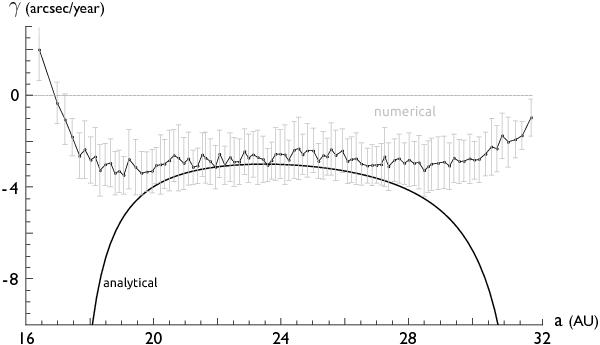Fig. 1

Example of apsidal precession, γ, in a self-gravitating disk. Here the disk is assumed to contain 50 M ⊕ between 16 and 32 AU, characteristic of a typical post-formation debris disk in the Nice model of solar system formation (Tsiganis et al. 2005). The solid curve shows the precession rate predicted by Eqs. (1)–(3), as a function of semi major axis. The dots and error bars show the results of a numerical calculation, integrating 3000 equal-mass particles with a softening parameter of ϵ ≈ 0.005 AU to smooth the effects of their mutual close encounters. The disk was binned into 100 annuli in a and the mean frequency of the longitude of pericenter  was measured from the time-series of ϖ of the particles in each bin (dots) as well as its variance (error bars). Note that the precession frequency of a self-gravitating disk is negative.
was measured from the time-series of ϖ of the particles in each bin (dots) as well as its variance (error bars). Note that the precession frequency of a self-gravitating disk is negative.
Current usage metrics show cumulative count of Article Views (full-text article views including HTML views, PDF and ePub downloads, according to the available data) and Abstracts Views on Vision4Press platform.
Data correspond to usage on the plateform after 2015. The current usage metrics is available 48-96 hours after online publication and is updated daily on week days.
Initial download of the metrics may take a while.


